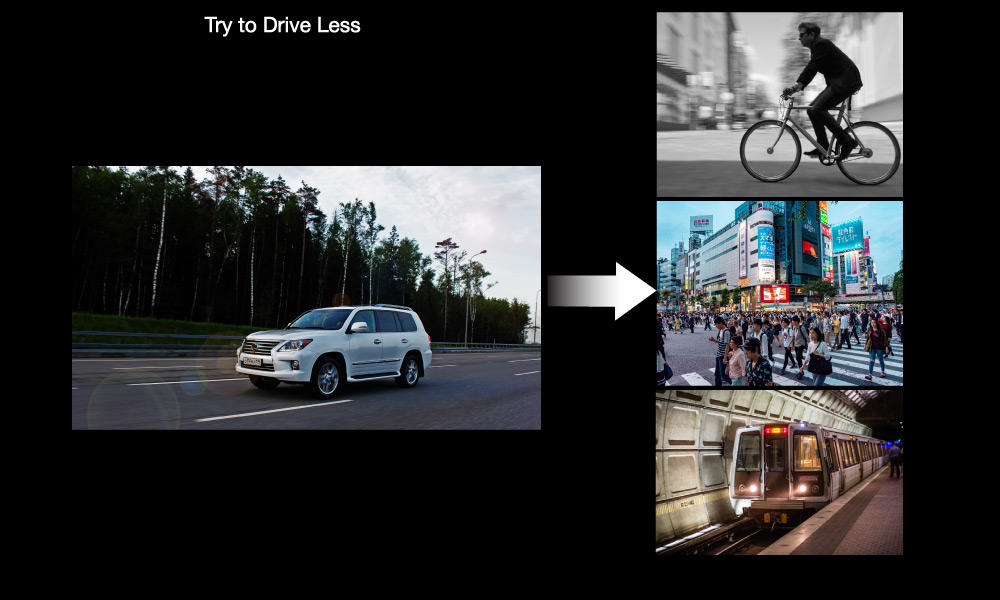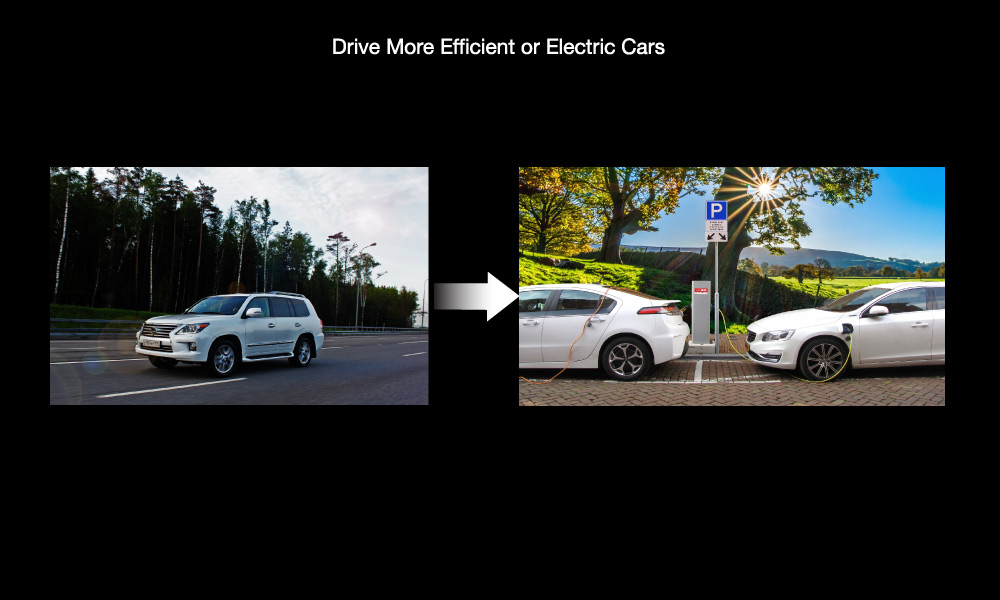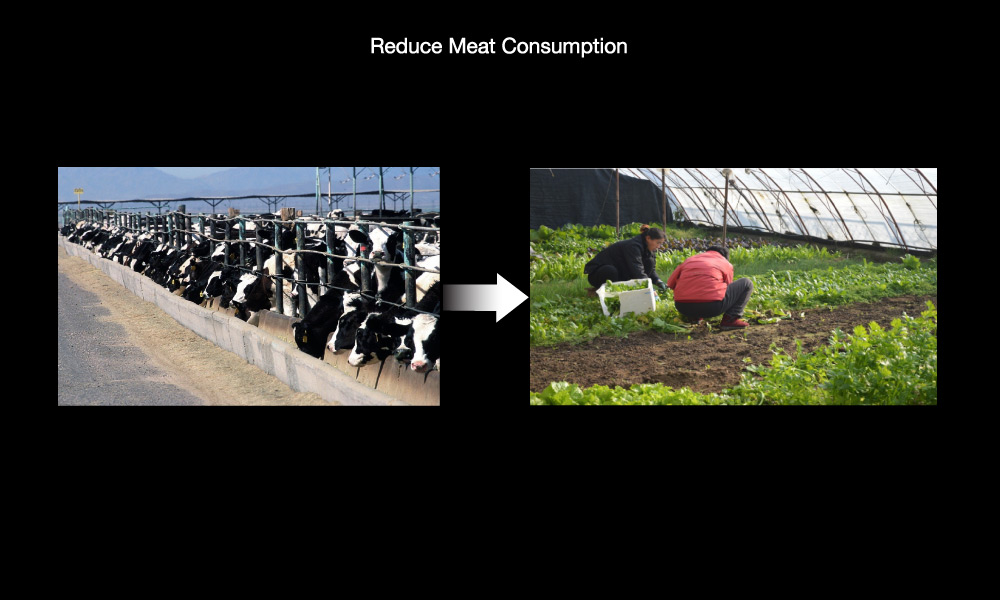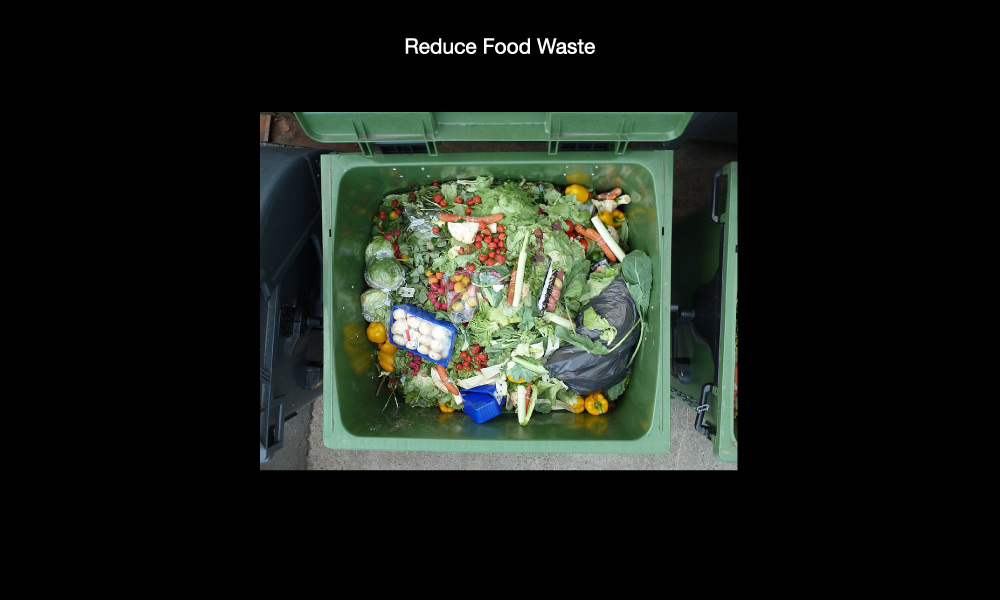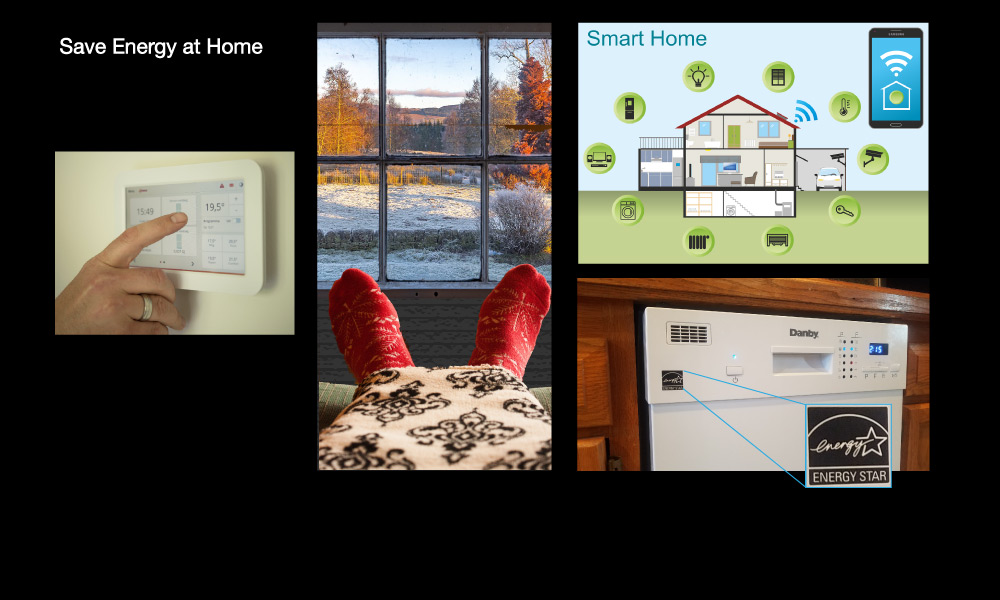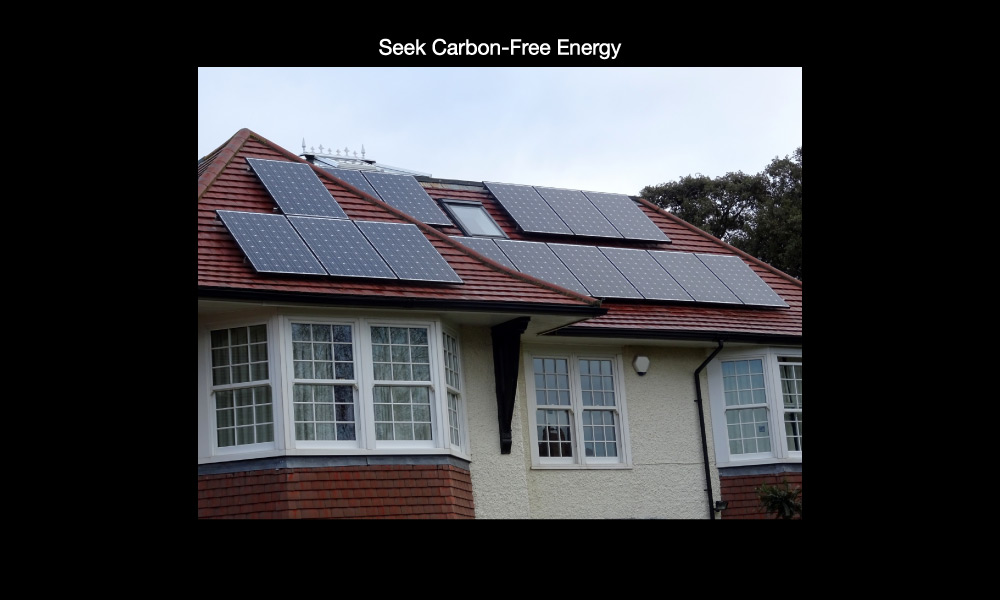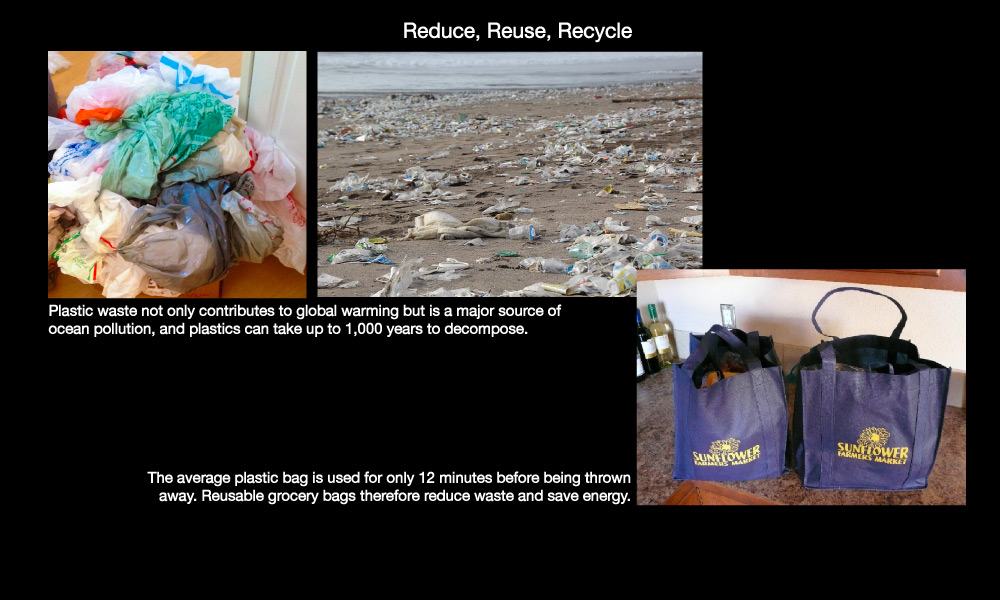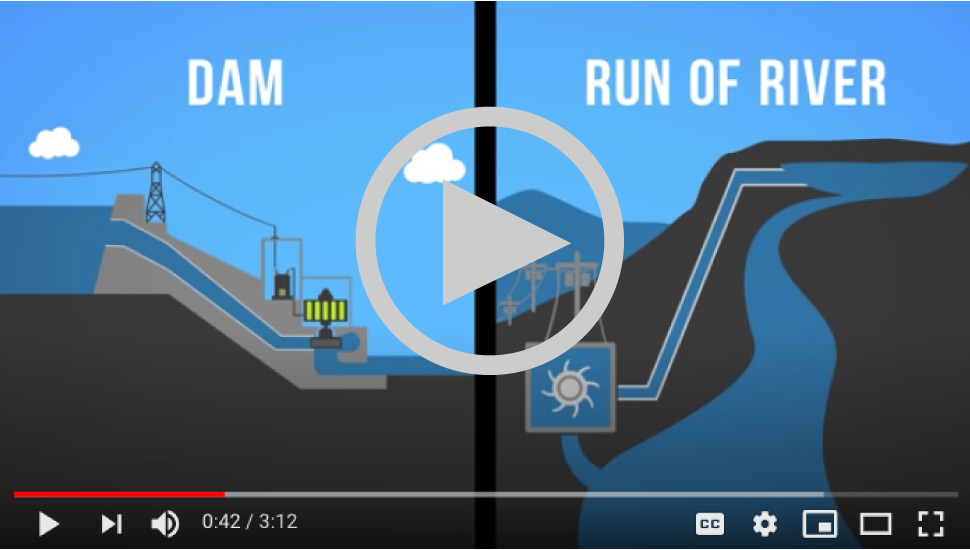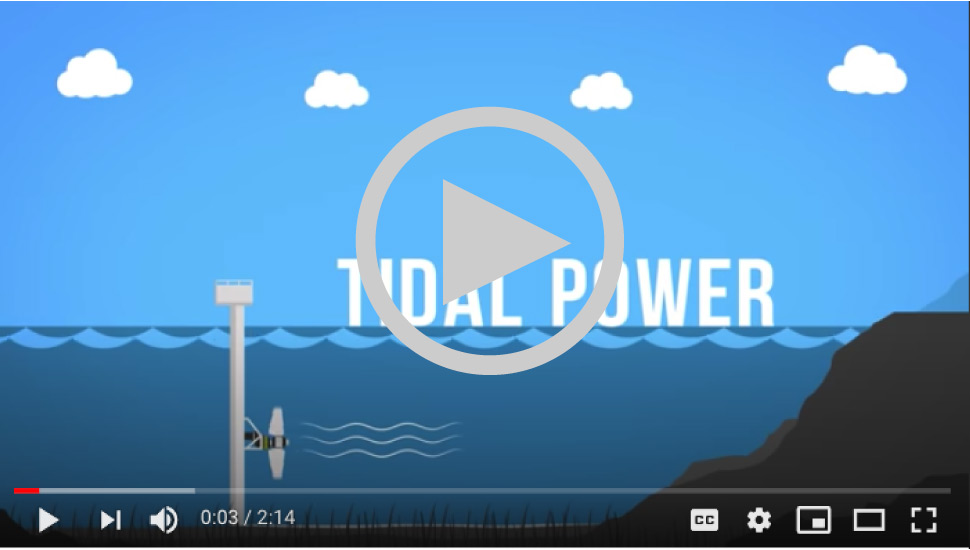We humans need a lot of energy to maintain our modern civilization. We will need even more energy in the future, because billions of people living in developing nations will require a lot more energy in order to raise their standard of living to that of the developed world.
The key issue for global warming, then, is where this energy will come from. As you already know, the only way to slow or stop global warming is to make sure that this energy no longer comes from fossil fuels (or, possibly, to capture their emissions — see the box to the right), since they are the primary source of the greenhouse gases that are causing global warming. Unfortunately, this is not an easy task, because the currently world gets the vast majority of its energy from fossil fuels (Figure 7.3.1–1).
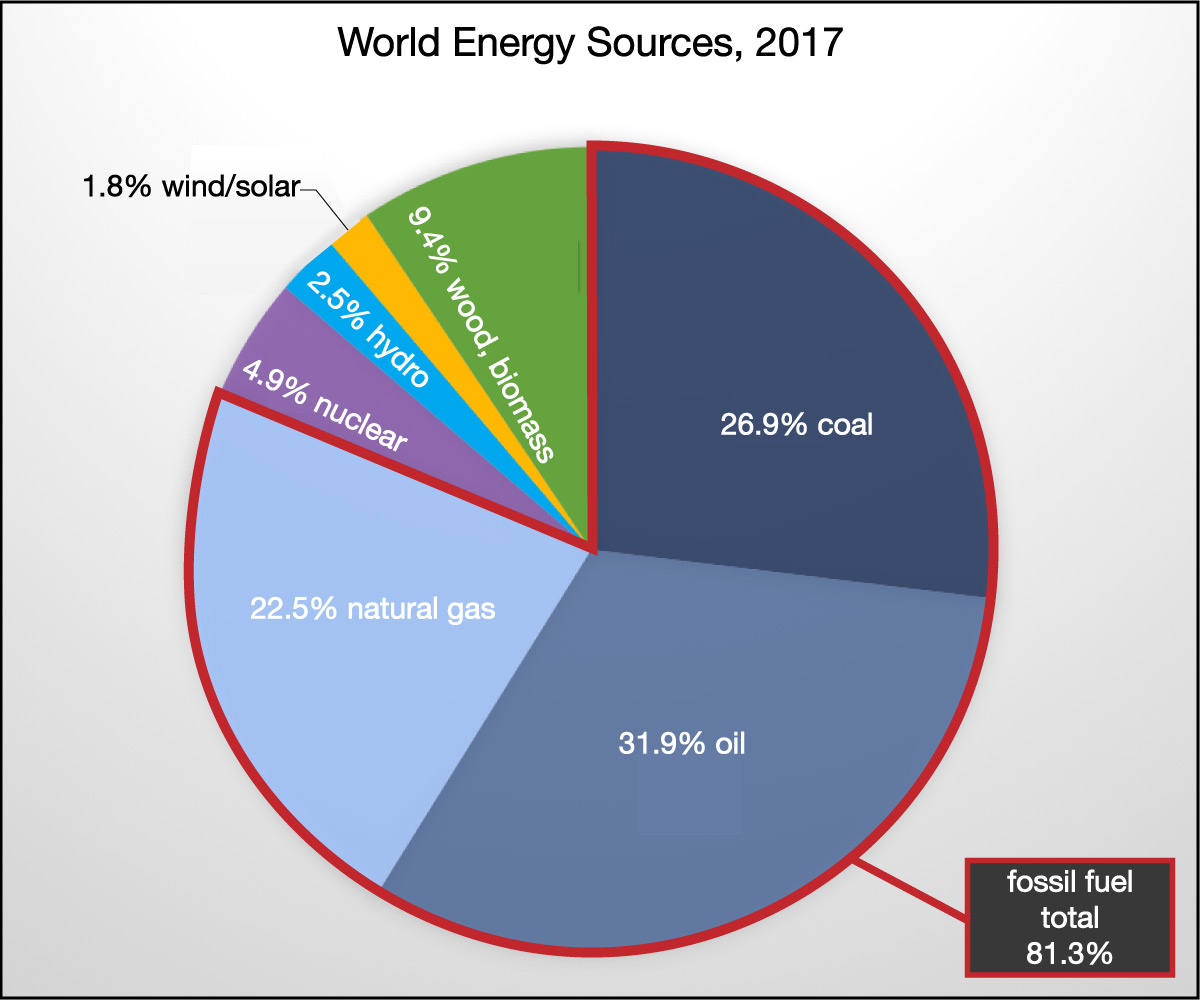
Nevertheless, it is possible, because we already have technologies that could in principle allow us to meet all our energy needs without continued use of fossil fuels. Broadly speaking, we can separate these technologies into three major categories:
- Energy efficiency
- Renewable energy
- Nuclear energy
In the rest of this section, we’ll briefly investigate these technologies, along with their benefits and drawbacks.
Activity
Energy Consumption Around the World
This activity will help you investigate differences in energy usage around the world. There are many online sources for the data you’ll need, but we recommend using this interactive map from the Our World in Data web site. When you link to this site, you will see a map like the one shown below, except it will be interactive so that you can click on individual countries to get details, use the time slider to see how energy usage has changed with time, or use the buttons at the bottom to see the data in other forms, such as a chart or table. To help you interpret the data, be sure to remember:
- The energy units shown in the key are “kWh,” which is short for kilowatt-hours. You can review what this energy unit means in this box from Chapter 4. The values are given per year.
- The words “per capita” simply mean “per person.” For example, if the map tells you that a country’s per capita energy usage is 50,000 kWh, it means that, on average, each person in that country uses 50,000 kilowatt-hours of energy per year.

- What is the average yearly energy use per person in your country? Is it high or low compared to other parts of the world?
- Using what you know about standards of living around the world, do you see any general trend between energy usage and standard of living? Explain.
Bonus: If you would like to be more quantitative , one way of describing a country’s overall standard of living is with something called the “Human Development Index,” which is compiled by the United Nations Development Program. Click here to see a map of this index in the same format as the map above. You can then compare energy usage and the Human Development Index in various countries. - The total energy usage of a country depends on both its per person (per capita) usage and its population. The world’s two most populous countries are China and India (you can use this map to see populations for any country), with a combined population that is more than 8 times that of the United States. What would happen to the world’s fossil fuel use if these countries continue to use fossil fuels but raise their per person energy usage as high as that in the United States? What would that mean for future global warming?
- Notice that the United States and Canada rank among the highest countries in terms of energy usage per person. But there are many other countries that have a similar (or even higher) standard of living but much lower energy usage per person, including several European countries, Australia, New Zealand, Japan, and Singapore. What could account for that difference, and how might it be relevant to finding ways to meet future energy demand around the world without causing too much more global warming?
This activity is designed to help students understand why global energy demand is expected to continue rising in the future.
- (1) The linked interactive map is an excellent way for students to get the data for your country. Simply roll over your country, and you will see the per capita energy use.
- (2) The general pattern is that developing nations use much less energy per capita. If you ask students to do the Bonus question, you could also have them look more quantitatively at the data, and even do some comparisons.
- (3) The basic answer is that their large populations mean that, if India and China were to have the same per capita energy usage as the United States, world energy usage would become much higher. Therefore, if they get this energy from fossil fuels, it will greatly exacerbate global warming. Again, using the linked data, you could have students do a more quantitative analysis.
- (4) This question should generate an interesting discussion, but the key point is that it is possible to have a high standard of living while using significantly less energy than is used in the United States and Canada. This is relevant to future energy demand because it tells us there are ways (primarily through efficiency) to achieve high living standards with lower energy usage. This could be an important contributor to solving the problem of global warming, and leads into the following discussion of energy efficiency.
Energy Efficiency
The cheapest and easiest way to make headway against global warming (and all related energy issues) is to reduce the demand for energy. After all, if we can live our lives while using less energy, then it will be much easier to find ways to generate the energy we need.
Note that the goal of energy efficiency is to reduce energy use, not to reduce quality of life. In fact, when done well, efficiency can improve quality of life. Broadly speaking, there are two basic ways to do this:
- Adopting technologies that use energy more efficiently, meaning that they require less energy to perform the same (or better) functions.
- Making lifestyle choices that allow us to live better and healthier lives while using less energy and/or reducing emissions of greenhouse gases.
We’ll consider a few examples of each.
Light bulbs offer a great example of how technological changes can improve energy efficiency (Figure 7.3.1–2). The purpose of a light bulb is to provide light. However, most of the energy that is needed to keep a light bulb on does not go to light; instead, it is wasted (primarily as heat). For example, old-fashion, or “incandescent,” light bulbs convert less than 5% of the energy they consume into light, which means 95% of the energy they use is wasted. Other technologies, including fluorescent lighting and LED bulbs, are about three to four times as efficient, which means they give off the same amount of light while using less than a third as much energy . Today, LEDs are the leading technology for lighting. (Many fluorescents are also in use and save similar energy, but they suffer a major drawback in making use of the toxic metal mercury.)
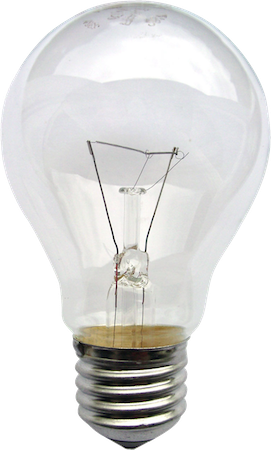
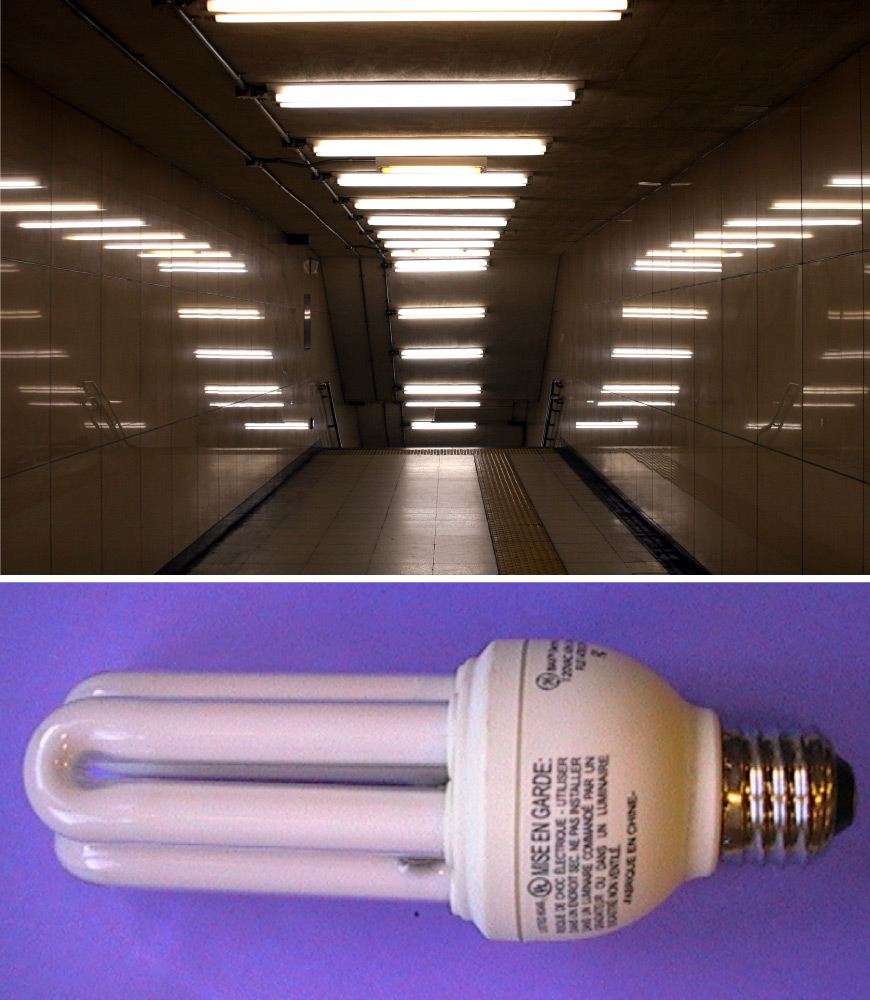
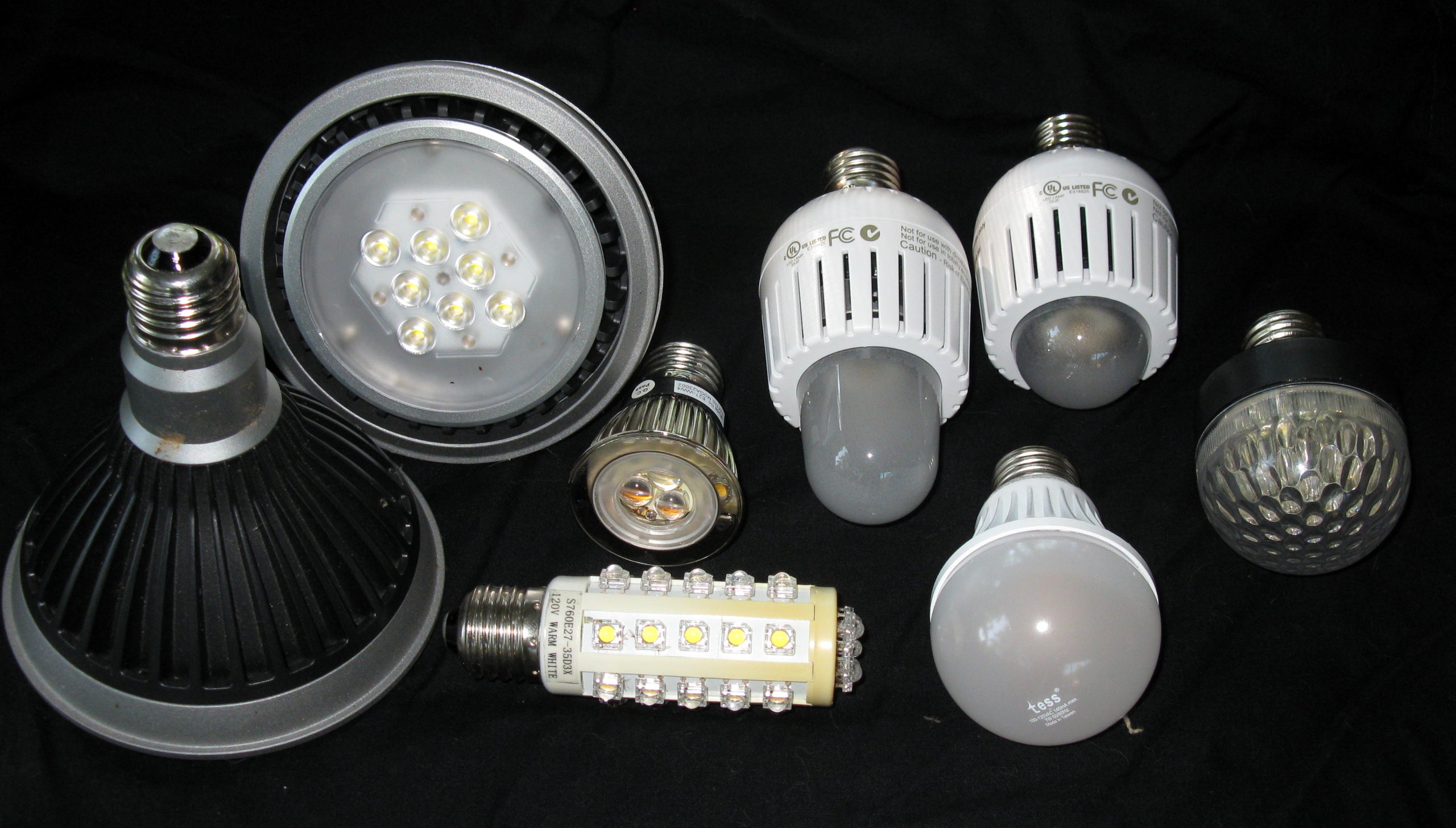
Figure 7.3.1–2 – These pictures show examples of three common lighting technologies.
Discussion
Light Bulb Replacement
Changing old light bulbs to more efficient ones would seem like an obvious step that everyone should take. The financial savings on electricity alone make it well worth it. For example, replacing just a single light bulb can easily save $20 to $40 per year in electricity costs (see the Do the Math box below). Nevertheless, many people have not yet made these lighting replacements. Discuss the following questions to help you understand some of the reasons why.
- The older (incandescent) light bulbs are generally cheaper than LED light bulbs that produce the same amount of light. By looking either in local stores or online, compare the prices of a 100-watt incandescent bulb and a 25-watt LED (which will produce as much or more light).
- Based on the prices you found for the two bulbs and the relative operating cost of the two bulbs, which bulb is less expensive overall, and why? Note that LEDs also generally last much longer than incandescent bulbs (up to about 10 times as long). How does this fact affect the comparative total costs of the two bulbs?
- If you go to the store to buy a light bulb, you pay only the purchase price. Your savings in energy costs and replacement costs (if one bulb lasts longer than another) is something you’ll get later, over time, but not at the time of purchase. How might these facts account for some people still choosing to purchase incandescent bulbs, despite their higher costs over time?
- Another objection that some people voice to LED bulbs is their “quality” of light. That is, even though a 25-watt LED puts out at least as much total light as a 100-watt incandescent, it can look a little different to your eyes. (In fact, you have options when you buy an LED bulb; for example, you can choose a bulb that gives off light that look more like daylight or one that looks more like an incandescent bulb). If possible, compare the light from LED and incandescent bulbs. Can you tell the difference? Do you prefer one or the other? Would any difference be enough to make you stick with the bulb that costs more in total?
This discussion should help students understand the price and energy advantages of more efficient bulbs while also exploring the resistance that some people have to change. A few notes:
- (1) Your students will probably find incandescent to be cheaper, but the gap has been rapidly narrowing. Typically, the price difference will be no more than about $5, and may be substantially less.
- (2) The up-front price difference is nowhere near enough to make up for the energy savings you’ll get from the LED, so the LED is much less expensive. The fact that the LED also lasts longer just magnifies this savings, since you’d have to replace the incandescent bulb up to about 10 times to match the lifetime of the LED, which means even the purchase cost of the LED ends up lower in the long run.
- (3) This question is really asking students to think about psychology. Many people focus only on the up-front cost, ignoring the cost of operating the bulb over time. This probably explains a lot of the resistance to newer lighting technologies, even though it ends up costing more in the long run.
- (4) The lighting quality issues are more subjective. If you are able to, it would help to bring in several different light bulbs that all put out the same total light and let students try them out to see what differences they notice in the lighting “quality.” Students can then discuss their personal preferences and whether there are any cases in which their preference might be enough to make them want the more expensive incandescent bulbs.
Similar savings of both energy and cost are possible in many other ways. Here are just a few examples:
- Installing better insulation and better windows can dramatically decrease the energy needed to keep a building warm in the winter and cool in the summer.
- Replacing appliances like refrigerators, washers, and dryers with more efficient models can greatly reduce electricity use.
- Driving a car that has better fuel economy (meaning it can go a longer distance on a particular amount of gas) means using less gasoline and therefore lower carbon dioxide emissions. Replacing a gasoline car with an electric car is generally even better, for two reasons: First, electric car engines are generally much more efficient than gasoline-powered engines, so the same total amount of energy will go much farther in an electric car. Second, if you get the electricity from a non-fossil source, such as solar panels on your roof, a wind power station, or a nuclear power station, then driving an electric car will not produce any greenhouse emissions at all.
Overall, improved energy efficiency is what you might call a “no-brainer”: It saves both energy and money, with no reduction in benefits or lifestyle. Moreover, because it means less total energy use, it can help reduce the future amount of global warming even if some of our energy is still coming from fossil fuels. And, of course, improved energy efficiency will make it easier to transition away from fossil fuels, since we’d need fewer new energy sources to replace the fossil fuels.
Activity
Home or School Energy Efficiency
Identify at least one significant use of energy at your school or at your home. For example, you could consider heating, cooling, lighting, kitchen appliances, transportation, or anything else that requires fuel or electricity. Investigate its current energy efficiency, then research ways in which it could be upgraded to become more efficient. Write up a short report giving your recommendations for changes that would save both energy and money.
This activity could range in depth from a brief, qualitative report (e.g., we should replace the school windows with ones that have better insulation) to a detailed, quantitative project in which students evaluate energy use in detail, and consider cost details. Be sure to guide students to the level of depth that you wish.
Lifestyle Choices and Carbon Footprint
The second general way we can reduce energy usage and greenhouse emissions is through lifestyle choices. Since our focus is on global warming, we will consider what is called your carbon footprint, which means the total amount of greenhouse gas that is added to the atmosphere as a result of the way you live your life. The same idea can be applied more broadly to groups of people, businesses, or communities.
Key Concepts: The Concept of the “Carbon Footprint”
The key to slowing or stopping global warming is to reduce or end emissions of carbon dioxide and other greenhouse gases. To quantify how much any individual or group is emitting, we use the concept of the “carbon footprint,” which represents that individual or group’s total contribution of greenhouse gases. For example, your individual carbon footprint is the amount of greenhouse gas released through your personal lifestyle and choices, a city’s carbon footprint is the total amount of greenhouse gas released by the city as a whole, and a nation’s carbon footprint is its total carbon emissions.
There are many ways that you can reduce your carbon footprint. Slide show 7.3.1-3 shows just a few examples, and you can surely think of many more possibilities. Be sure to notice that while some of these choices might seem like they require lifestyle sacrifices, in many cases they can also enhance your life. For example, driving less by walking or riding a bike can keep you healthier, and taking mass transit to school gives you time to study on the way and reduces the risk of getting stuck in traffic.
Slide Show 7.3.1–3 – There are many ways to reduce your energy use and your carbon footprint. These slides offer just a few examples.
Activity
Carbon Footprint
Coming Soon . . .
Walk your students through an exercise where they use an online calculator to evaluate their carbon footprint.
Renewable Energy
Energy efficiency can certainly help to reduce our greenhouse emissions from what they would be otherwise, but even in the best case, humans will still need a lot of energy resources. Remember that this is particularly true as we seek to raise the living standards of people around the world. Therefore, if we are to avoid the most serious consequences of global warming, we must find a way to supply that energy without the greenhouse gas emissions that come from fossil fuels. This will be a big task, because fossil fuels currently supply the vast majority of the world’s energy (see Figure 7.3.1–1).
The most fashionable alternatives to fossil fuels are renewable energy sources such as wind, solar, geothermal, hydroelectric, and biofuels. While none of these sources are perfect — for example, solar panels contain toxic chemicals, wind turbines can kill birds and bats, and dams for hydroelectric power can damage river ecosystems — they have the advantage of producing energy without increasing the concentration of carbon dioxide or other greenhouse gases in our atmosphere. Debates about renewables therefore focus on how much energy they can realistically provide, whether they are cost-effective, and their relative pros and cons.
As we discuss renewable (and other) energy sources, it will be helpful if you review the units we use to measure energy and power in Section 4.2.3. (It will also help to do the Activity below.) Recall that current total world power consumption is approximately 15 terawatts, meaning that as a civilization, we use about 15 trillion joules of energy each second.
Activity
Units for World Power and Energy
The close relationship between energy and power sometimes causes confusion, because when you look up energy data or read about it in the media, it is sometimes talked about in terms of energy and sometimes in terms of power. Try the following questions to help you review the basic ideas and to be prepared for data and media reports you will encounter. You can do this activity individually, in pairs, or in small groups.
- Recall that the standard international unit of energy is the joule and the standard unit of power is the watt. How are these two units related?
- Use your prior answer to write a more general formula that starts with “energy =” and uses power and time on the right side of the equation.
- Review this box, which explains another common energy unit called the kilowatt-hour. What is a kilowatt, and what is the definition of a kilowatt-hour? How does this definition fit in with the formula you found in question 2? What is a kilowatt-hour equivalent to in joules?
- Again reviewing Section 4.2.3, as needed, define a megawatt, gigawatt, and terawatt.
- Define a megawatt-hour, gigawatt-hour, and terawatt-hour.
- We’ve stated that current world power consumption averages about 15 terawatts. Suppose you instead want to state how much energy the world uses each year. What units would be the most convenient? How much energy does the world use each year in those units?
This activity will help students understand why we often hear global energy discussions both in terms of power (such as watts or terawatts) and of energy (such as joules or terawatt-hours). Note that while the math in this activity is very simple, the ideas may be challenging for students because of the common confusion between energy and power. Notes on the answers:
- (1) As stated in Section 4.2.3, 1 watt = 1 joule/s.
- (2) From question 1, students should recognize that power = energy/time. Therefore, we can equivalently write energy = power x time.
- (3) A kilowatt is 1,000 watts, and as stated in the box, a kilowatt-hour is defined as the total amount of energy that you consume in 1 hour if you are using 1 kilowatt of power. This means that 1 kilowatt-hour = 1 kilowatt x 1 hour; students should note that this formula has the same form as the general formula energy = power x time. As shown in the same box, 1 kilowatt-hour is equivalent to 3.6 million joules.
- (4) A megawatt is 1 million watts, a gigawatt is 1 billion watts, and a terawatt is 1 trillion watts.
- (5) Following the same logic used to define a kilowatt-hour, we find that:
1 megawatt-hour = 1 megawatt x 1 hour
1 gigawatt-hour = 1 gigawatt x 1 hour
1 terawatt-hour = 1 terawatt x 1 hour - (6) Because the world power consumption is given in terawatts, the most convenient energy unit will be terawatt-hours. To find the worlds annual energy usage, then, we simply multiply the power usage by the number of hours in a year:
global annual energy = global power usage x number of hours in 1 year Plugging in the numbers, we find:
global annual energy = 15 terawatts x 24 hr/day x 365 day/year = 131,400 terawatt-hours Rounding to two significant digits, the global annual energy usage is about 130,000 terawatt-hours.
Wind
We’ll look briefly at each of the five major types of renewable energy, starting with wind power. You have probably seen huge wind turbines that can generate electricity. They can be installed either on land or offshore (Figure 7.3.1–4).


Figure 7.3.1–4 – Wind turbines can be located either on land or offshore. Offshore winds are often steadier, but of course they are available only along coastlines.
Overall, wind is a remarkably clean and safe way to generate energy. The operation of wind turbines not only produces no greenhouse gases, but also does not produce any other air or water pollution. In fact, the only significant pollution associated with wind power comes in the production of the wind turbines themselves. For example, there is inevitably pollution associated with the mining of the materials for wind turbines, and there may also be pollution associated with their manufacture, transport, and assembly (depending on the energy source used for those processes). The only other significant environmental impacts of wind turbines come from the land use required for them, the danger that spinning turbines pose to many birds and bats, and the fact that their materials must be disposed of (or, better, recycled) when they need to be replaced or removed.
Moreover, the cost of wind power has dropped dramatically in the past couple decades, and it is now generally cheaper to produce energy with wind than with fossil fuels. As a result, wind has been generating a rapidly growing (though still small) fraction of the world’s electricity. Figure 7.3.1-5 shows data on the installed wind capacity, meaning the total power that could be generated if all the installed wind turbines were operating at the same time.
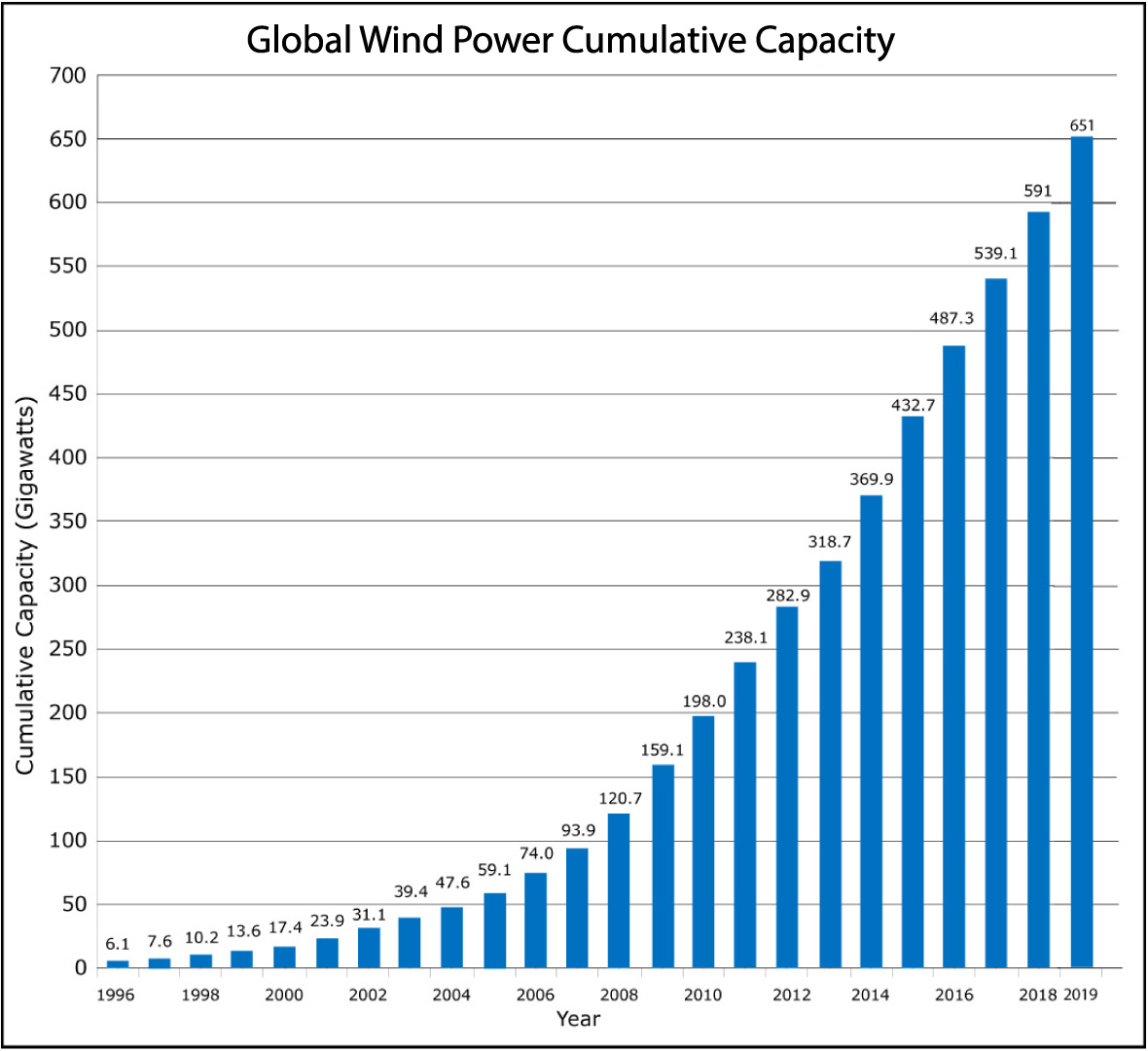
So is wind the solution to all our problems of global warming? While it has great potential, wind also faces numerous challenges. Try the following questions to see what you already know or can figure out about some of the challenges of wind power and how they might be met.
Discuss the following questions with a classmate. Then click to open the answers to see if they agree with what you came up with.
1. Perhaps the biggest single issue in thinking of wind as a solution to global warming is the issue of “scaling up” existing wind power to the level needed to replace the energy we currently get from fossil fuels. How close are we to generating enough energy with wind to replace the use of fossils? Hint: Look back at Figure 7.3.1–1.
Figure 7.3.1–1 shows that we are not close at all. Wind and solar together represent less than 2 of the world’s energy supplies, while fossil fuels represent more than 80%. This means we’d have to “scale up” wind and solar by a factor of more than 40 to replace fossil fuels. For more details on the challenge of scaling up wind power, see the Do the Math box below.
2. Another issue with wind power is that it is an intermittent (which means not steady) source of energy, because it provides power only when the wind is blowing (and not blowing so hard that the turbines must be shut down for safety). What makes an intermittent power source more challenging to use than a steady power source (such as that provided by most fossil fuel power plants)?
Homes, schools, and businesses generally need steady power, so if a power source is intermittent, it must somehow be “smoothed out” in order to be useful.
3. Wind power is generally used to produce electricity that flows into the electrical grid , which is the network of power stations and power lines that moves electricity from the places where it is generated to the homes and other places where it is used. Suggest at least one way in which the grid might in principle be used to “smooth out” the intermittent power of wind.
If the grid is large enough, then in principle it could be used to move electricity from places in the grid where the wind is currently blowing to other places where it is not.
4. As a follow-up to question 3, what practical difficulties do we face in using the grid to smooth out the intermittent power of wind?
First, unless the grid is very large, the total amount of power available from wind is still likely to vary significantly with time. For example, even in a grid covering the entire United States, it’s unlikely that the total wind power generated would stay constant with time across the country. Second, the existing grid cannot move electricity to where it is needed quite so easily, so we would need to upgrade the grid with what is often called a “smart” grid.
5. How could the use of batteries or other energy storage help with the issues of wind power?
Energy storage could solve most or all of the problems with the intermittent nature of wind. The idea is this: At times when wind is generating more power than is needed, we would use batteries or other storage systems to store the excess energy, then use this energy at other times when the wind is not supplying enough power.
6. While wind power can easily produce electricity (see the I was Wondering box above), it is not a transportable fuel like gasoline for cars, or the gas or oil used in many places for home heating. Can you think of a way in which wind power could still provide energy for cars or home heat?
Wind could provide this energy if we convert the current systems from the fuels they now use to instead use electricity, a process usually called electrification . For example, if we make a switch from gasoline-powered to electric cars, then electricity from wind can be used to charge the car batteries. Similarly, if homes use electric heating instead of gas or oil heating, then the heat could come from wind-generated electricity.
7. Another technology that can help wind meet our power needs is the production of a transportable fuel, such as hydrogen (made by splitting water molecules), with wind energy. Look up “hydrogen fuel,” and briefly state why it is useful in general and how it could be used in conjunction with wind.
Hydrogen is an excellent fuel because it packs a lot of energy and can be transported in either gas or liquid form, and because the only “pollutant” it makes is water. Hydrogen can be burned directly to produce energy, or it can be used in what are called fuel cells . Because fuel cells are portable, they can in principle be used to meet almost any energy need, including in cars, buses, airplanes, spacecraft, and more. Hydrogen could be useful in conjunction with wind because it could help both with wind’s intermittency (by storing energy to smooth out the power in the grid) and with making the energy portable for use in transportation.
It’s also worth noting that while wind power has many advantages over fossil fuels, the installation of wind turbines often faces local opposition, primarily due to aesthetics (for example, claims that they’ll ruin a beautiful landscape), the land they require, or the noise they can generate. This type of opposition has stalled numerous proposed wind projects. On the other hand, wind is often popular with farmers and ranchers, because they can earn money by leasing their land for wind turbines while still making use of most of their land.
Discussion
“Electrify Everything”
As we’ve discussed, one of the challenges of many renewable energy sources is that they can be used to generate electricity much more easily than they can be used to produce transportable fuels. For this reason, some people advocate that we “electrify everything,” so that we can use electricity in all cases. Briefly discuss the following questions related to this idea.
- Identify at least three uses of energy in your home, school, or community that do not currently run on electricity.
- For each time on your list, briefly discuss whether and how it could be electrified, and whether you think this would be a good idea.
This is a very brief discussion, designed primarily to make sure that students understand the concept of electrification. Lists will vary, but three very common items will be gasoline for cars and buses, gas or oil for heating, and gas for cooking.
Discussion
Wind Power Challenges
Working in small groups, answer the following questions about wind power.
- Based on what you have learned in this section, make brief lists of the benefits and the challenges of wind power.
- Despite the rapid growth in wind power, it still represents a very small fraction of the world’s energy. Do you think it is realistic to imagine wind power replacing, say, half of fossil fuel usage by the year 2050? Why or why not? (Note: You may find it helpful to have read the Do the Math box above before answering this question.)
- In general, wind farms are operated by private businesses. If you were the owner of a wind power company, what kinds of factors would you consider in deciding whether and where to build a new wind farm? Do you think it is possible that many small wind companies could contribute to the kind of global installation needed to replace a large fraction of fossil fuel use?
This discussion is designed to make sure students understand the benefits and challenges of wind power, and also to think about what it takes on a practical level to install more wind power. It should especially help reinforce what they learned in the above Q&A with a classmate.
- (1) Lists will vary, but here is a sample:
Benefits - Wind power does not produce greenhouse gases.
- Wind power also does not produce any other air or water pollution.
- Wind is widely available at fairly low cost; most countries have at least some accessible wind supplies (meaning areas where it makes economic sense to install wind turbines).
- Wind is often popular with farmers and ranchers, because they can earn money by leasing their land for turbines while still making use of most of their land.
- Wind is an intermittent source of power that can pose difficulties for the electrical grid.
- Wind is good for producing electricity, but not for replacing fuels such as gasoline.
- Wind turbines can kill bats and birds.
- Wind turbines are large, which means a lot of materials must be mined to make them, and so far there is little market for recycling these materials when a turbine no longer works.
- Wind turbines often face local opposition due to aesthetics (for example, claims that they’ll ruin a beautiful landscape) or to the noise they can generate.
- (2) This is a subjective question, but the key point (which students will understand best if they’ve done the Do the Math box) is that reaching that kind of wind power total would require an enormous global effort at installing new wind capacity. Therefore, student answers to this question come down to their opinions about whether they think that kind of effort might actually be made, which leads into the next question.
- (3) This question asks students to think from a business perspective. For whether to build a wind project, the main considerations would be the economics of it — can it successfully compete with other energy projects (and especially with fossil fuels), especially in light of challenges like intermittency. For where, you want to find a location that has plenty of wind and is close enough to population centers that there is likely to be a power grid in place that could handle the capacity. The last part of the question is particularly subjective, but most economists think that it is possible for many small companies to add up to a major global effort.
Challenges
Discussion
NIMBY
Local objections to wind turbines raise an interesting point: The consequences of global warming affect people everywhere, but solutions like the installation of wind turbines have disproportionate effects (aesthetics, land use, noise) on the people who live near them. The result is that while most people are in favor of wind power in general, many are opposed to having wind turbines located near them, a type of opposition that is sometimes called “NIMBY” for “not in my backyard.” What do you think of NIMBY arguments in general? Do you think they can be reasonable when it comes to wind projects?
This discussion can range from a very brief one to introduce the concept of NIMBY to a much longer and open-ended one, depending on how you choose to structure it. We include it in part because it is a general issue that students should be aware of, but also because it will be useful if you assign the Activity “Debate a Local Wind Project” (below). A few notes:
- The general concept of NIMBY can provoke very interesting social justice arguments. For example, more affluent communities generally have more resources for organizing opposition, with the result that many controversial projects end up being built in less affluent communities.
- With regard to wind power and NIMBY, a particularly interesting point concerns how we “feel” effects. For example, wind turbines clearly offer great environmental benefits compared to fossil fuels, but these benefits are globally distributed, while only the people living near the windfarm will feel its local drawbacks. Indeed, this has led to some somewhat strange controversies, in which people who support 100% renewable energy nevertheless have opposed wind projects in their own communities. This idea, of course, leads to the debate activity below.
Activity
Debate a Local Wind Project
As we’ve noted, wind projects are often controversial despite their many overall benefits. Choose one of the following two options for conducting a debate on a wind project.
Option 1: Are there any major wind farms located near you? If so, identify one and research it as the topic of this debate.
Option 2: If you don’t have a nearby wind project, identify a wind project somewhere around the world (either existing or proposed) that has generated controversy and research it for this debate. There are many wind projects you could investigate, but here are three to consider: The Nantucket Sound wind project (sometimes called “Cape Wind”); the Na Pua Makani wind project in Hawaii; or the Tarfaya wind project in Morocco.
Divide into two teams:
- Team 1 will research and present arguments in favor of the project. That is, arguing that the correct decision was made in building it if it already was built, or in favor of building it if it is not already built.
- Team 2 will research and present arguments against the project.
Each team should carefully research and clearly present the arguments for their team’s position. After the debate concludes, you can disband the teams, and then hold a class vote on whether you think the project should (or should have gone) forward.
This activity should help students understand both why wind is generally considered to be an excellent energy source and why it often sparks controversy nonetheless. They should bring to bear the various ideas already discussed, including the NIMBY idea from the prior Discussion.
Solar
Like wind energy, solar energy has become much less expensive in recent years. As a result, you can now see solar energy in use in most parts of the world. Broadly speaking, there are three major ways in which people are tapping solar energy today (Figure 7.3.1–6):
- Solar thermal systems use sunlight for heating, most commonly to make hot water (Figure 7.3.1–6a). These systems are particularly common in warm climates, where they can often provide all the hot water needed for a home, school, or business.
- Photovoltaics , which are “solar panels” used to convert sunlight into electricity (Figure 7.3.1–6b).
- Concentrated solar power systems, which use mirrors or lenses to concentrate sunlight on some central structure, called the “receiver” (Figure 7.3.1–6c). The receiver can then put this energy to use in several different ways. The most common are for generating electricity, storing the energy (which essentially makes the receiver into a giant battery), or for powering chemical reactions that can produce other fuels such as hydrogen.

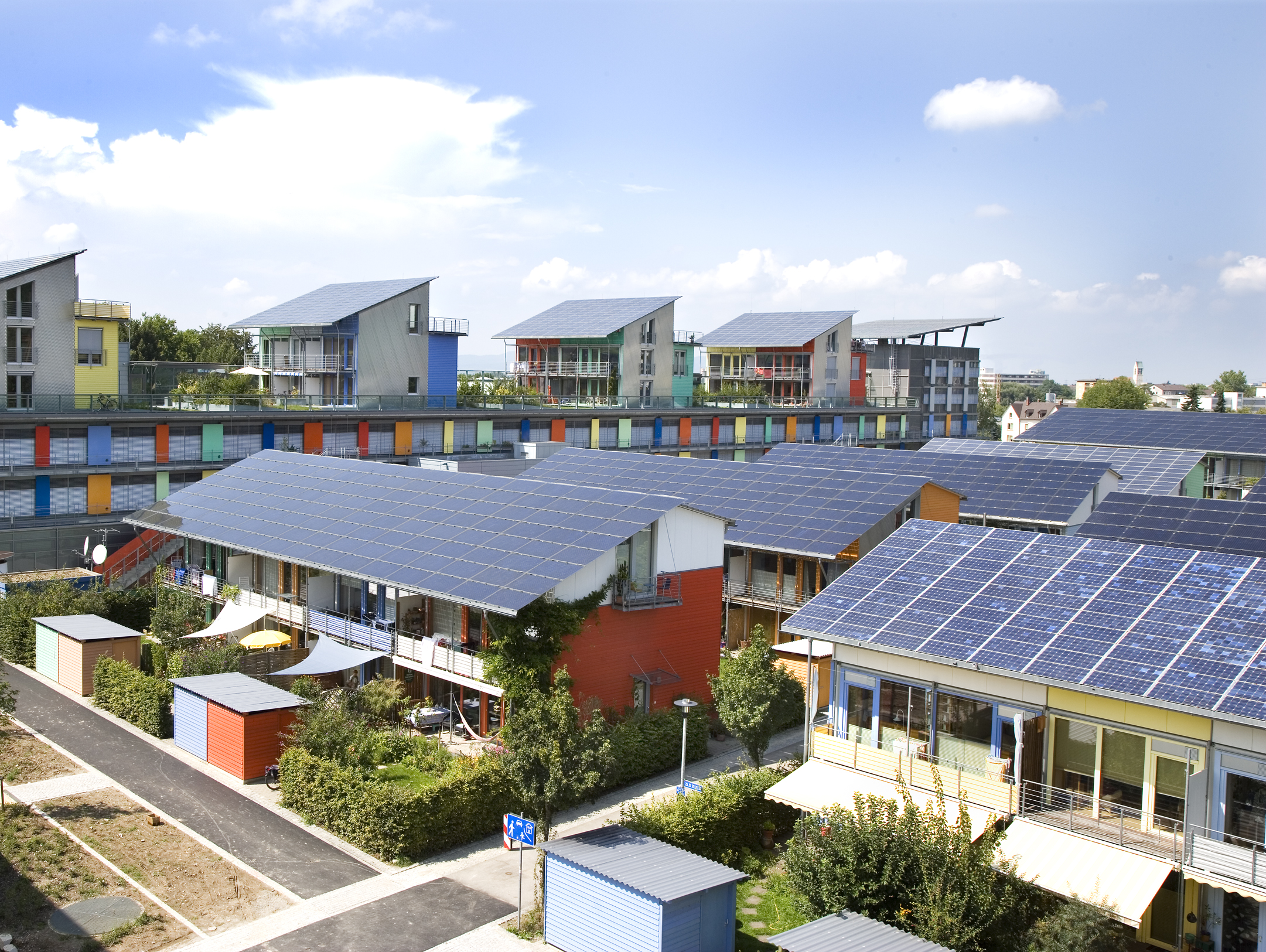
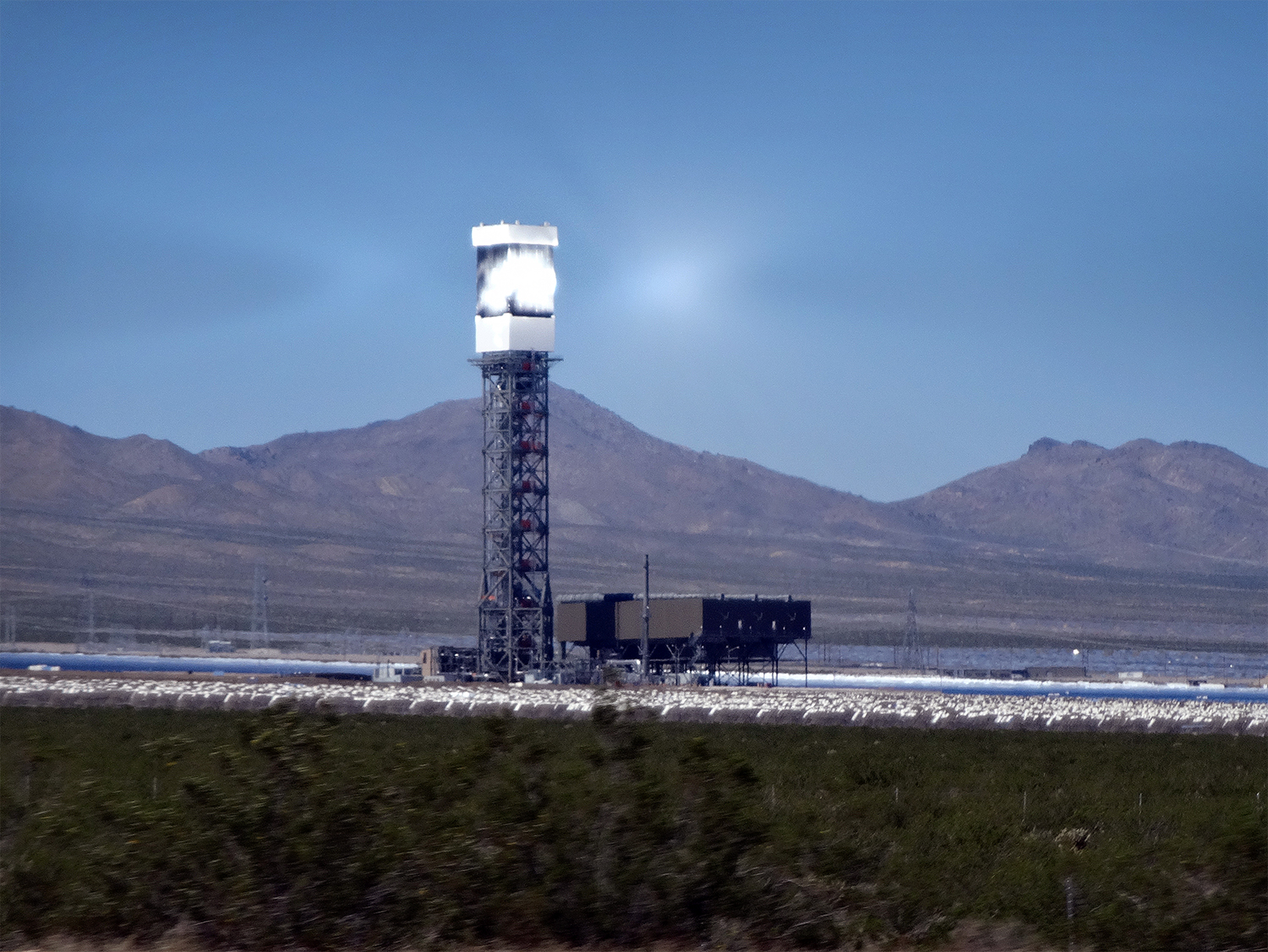
Figure 7.3.1–6 – These photos show three major ways in which sunlight is used to supply energy for human activities.
The global potential for solar energy is enormous. The total amount of solar power reaching Earth in the form of sunlight is more than 20,000 times current world power usage. In other words, if we could somehow tap just 1/20,000 of the energy that reaches Earth in the form of sunlight, it could meet all of our energy needs. Because the amount of available solar energy varies by location (largely due to latitude and weather), and because solar systems cannot convert 100% of the sunlight that hits them into energy, capturing this much solar energy would require solar systems covering roughly 1/1,000 of Earth’s surface. Figure 7.3.1–7 shows one way of envisioning what this land area looks like to scale on a world map. Although the required area is small compared to the world’s total area, it is still quite significant. For example, even if we put solar panels on every rooftop in the world, it would still add up to only a few percent of this needed area.
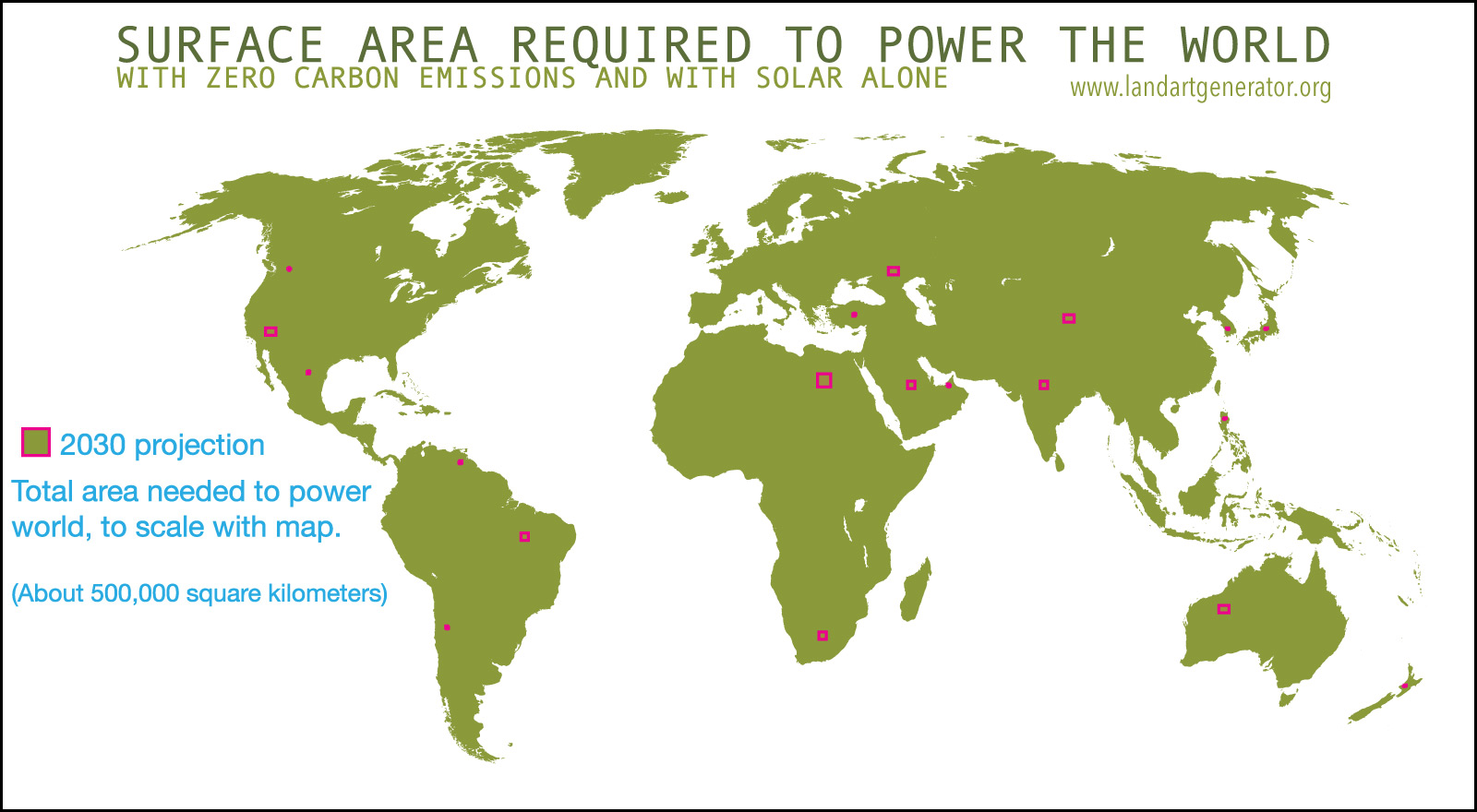
Besides the challenge of covering enough area to make a large dent in fossil fuel use, the other main challenge of solar is the same challenge we face with wind: it is an intermittent energy source, available only in daytime and when it is not cloudy. This can create particular challenges at high latitudes (such as in northern Europe), because these latitudes get very little daylight during the winter, and while they get plenty of sunlight in summer, there is not currently an easy way to store that energy for later use.
Despite the challenges, solar power is likely to play a large role in a transition away from fossil fuels. Aside from land use, its only other significant downside is in the materials that must be mined, manufactured, and eventually disposed of or recycled (once they exhaust their useful lifetimes). Some of these include toxic metals and other chemicals, which makes recycling particularly important for solar panels, since otherwise these would leach into the environment.
Activity
Solar Project
In this project, you will investigate the value of solar panels on either your school, your home, or another local building (such as a nearby store or other business). To begin, choose the building you will investigate, then do the following:
- Find electricity bills for the building. How much electricity does the building use in an average month, and how much does it cost?
- If the building already has solar panels: Find out how much electricity they produce in an average month. If the current solar does not fully cover the electricity use, find out how much more room there is for additional solar panels on the roof.
If the building does not already have solar panels: Figure out where they might go on the roof, and how much room there is for them. Be sure to consider only placements that would work well for solar panels. For example, you want to put them in a place that is not heavily shaded by trees or other buildings, and it should be possible to orient them in a direction that will be in sunlight for a large portion of a sunny day (generally toward the south in the northern hemisphere or toward the north in the southern hemisphere). - Research the average amount of energy per month (averaged over the full year) that you can expect solar panels to produce in your area, assuming they are well placed. Does your building have enough roof space for all the panels that would be needed to fully cover its electricity use? If not, about how much of the total electricity use could be covered?
- Research the cost for installing solar panels in your area. Be sure to include both the cost of the panels and the cost of installation, as well as any locally available incentives (such as tax credits) that can reduce the cost. Based on your research, how much would it cost to install the panels needed to either fully cover the building’s electricity use (on average), or to cover as much of it as there is room for on the roof?
- Based on your prior answers, how long would it take for the solar panels to pay for themselves through savings of electricity costs?
- Decide whether you think it would be a good idea to install solar panels (or additional ones, if some are already there) on the building. If you think it is, prepare a presentation to the people who make decisions about the building to try to convince them to go ahead with an installation.
This is project may be time-consuming and challenging, but could have very practical benefits. A few notes:
- In general, this project will work best if students are investigating a building where installation of solar panels would be practical. That is, a building that has good rooftop space available and that does not already have solar panels blanketing that space. Therefore, you should help students select a good building for this project. The project will be especially meaningful if, in the last step, students are actually able to do a presentation and convince the building owners to move forward with a solar installation.
- Students will also need access to electric bills for the building and to basic information about rooftop space available, so you’ll need the cooperation of the owners in being willing to provide students with this information.
- For learning about the potential power generation and costs of solar in your area: There are likely to be many local resources available, but if possible, you should consider inviting someone from a local solar company to offer a presentation to students. You will probably find many people willing to do this, especially since some of these projects could lead to business for their companies.
Geothermal
The third renewable energy source we’ll discuss is geothermal energy , which means energy extracted from Earth. There are two major but very different ways to take advantage of geothermal energy.
The first is to use heat from deep within the Earth. This heat can be used to generate clean and efficient energy, but it is generally available only near volcanoes, geysers, or hot springs. Still, that means a lot of places, and geothermal energy is becoming increasingly common in such areas. Iceland, for example, now gets the vast majority of its energy from geothermal power plants (Figure 7.3.1–8).
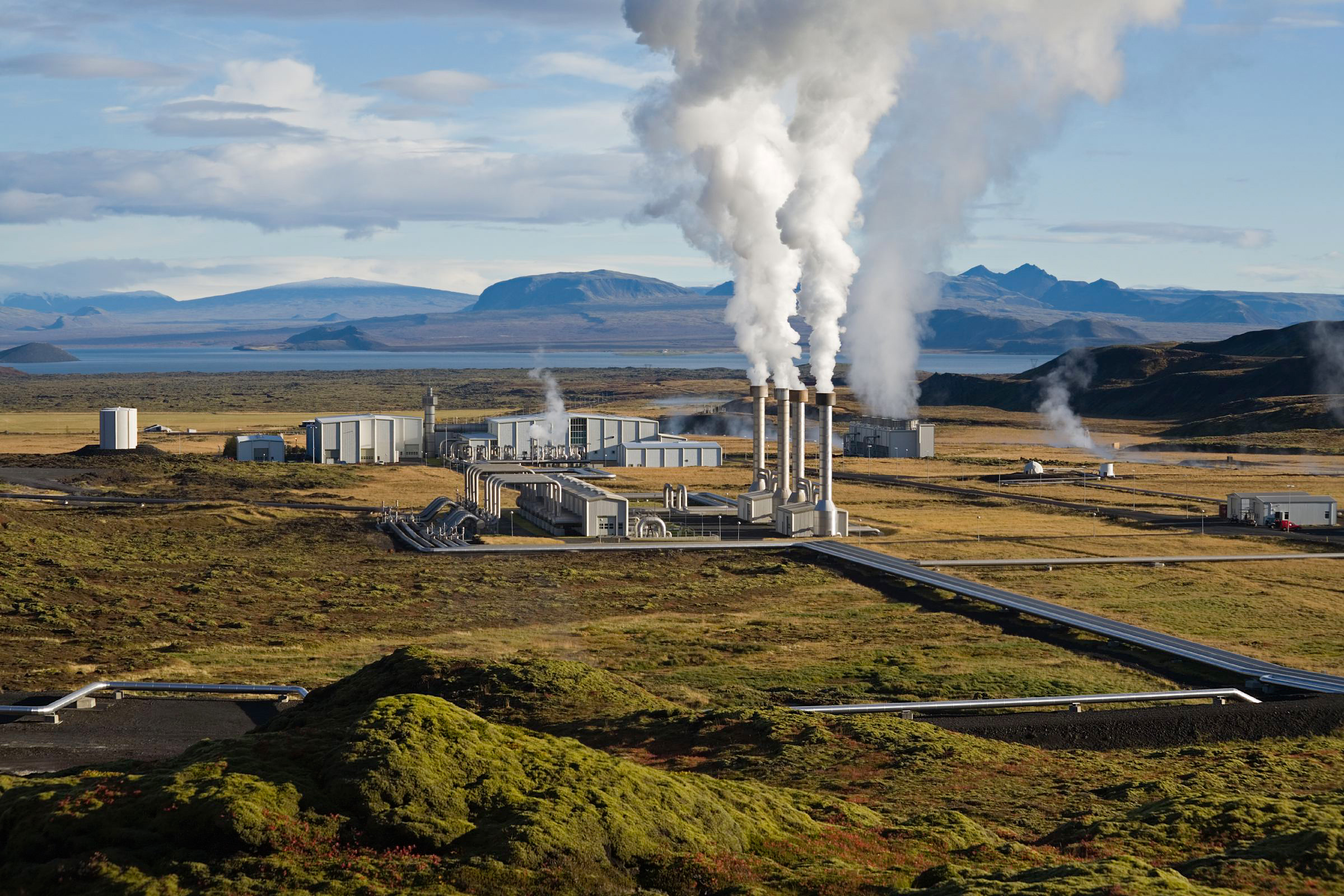
The second way of getting energy from Earth is much simpler and can be used almost anywhere. It is often called a geothermal heat pump (or “ground source” heat pump), and it simply takes advantage of the fact that if you drill down just two to three meters, the ground stays at an almost uniform temperature all year round. It is therefore possible to use a simple “heat exchanger” to extract heat from the ground in winter and dump heat into the ground in summer, which means that it can provide both heating and air conditioning. Video 7.3.1–9 explains how these systems work. If more widely implemented, these systems could meet much of the world’s residential and business needs for heating and cooling.
Video 7.3.1–9 - This short video explains the basic operation of geothermal heat pumps, which could in principle meet much of the world’s needs for heating and cooling. Credit: U.S. Department of Energy.
Activity
Geothermal Energy
Option 1: If you live in an area where geothermal energy from volcanic sources is available, find out whether any of that energy is currently being tapped by power plants. If so, research how the plant works, how much energy it is providing to your community, and how it might be expanded in the future. If not, find out why not, and whether there is potential to tap the energy. Write a report on your findings.
Option 2: Find out whether geothermal heat pumps can provide energy efficiently in your area. If they can, then do a project in which you investigate what it would take to install such a heat pump for either your school or another local building (home or business). If they cannot be, write a report on why not, and discuss where they would be effective to install.
This project will help students investigate the local potential for geothermal energy. We offer two options, depending on what makes the most sense for your local area. You can assign this activity either individually or to small groups.
It’s worth noting that geothermal heat pumps can be used effectively almost anywhere in the United States, as well as in much of the rest of the world. As a personal example: The lead author (Dr. Bennett) has a geothermal heat pump for his home, using a vertical loop. Although drilling the loop was an expensive process, the system paid for itself through energy savings within just a few years. More specifically, a careful analysis shows that the system reduced his home’s total energy usage for heating by about 75%, and more than that for cooling. Moreover, because the pump runs on electricity, and his home gets its electricity from renewable sources (solar and wind), the geothermal heat pump means that his home no longer produces greenhouse gas emissions from either heating or cooling.
Hydroelectric
Hydroelectric power means electricity produced with water, such as that produced by dams on rivers. A dam basically uses gravity to generate energy: It forces downhill-flowing water through openings that drive turbines to make electricity. Figure 7.3.1–10 and the accompanying video show the basic operation of a dam-based hydroelectric power system.

Hydroelectric power is currently the world’s largest source of renewable energy, because it is both clean and relatively inexpensive. However, while it does not produce any greenhouse gases directly, the construction of dams can in some cases lead to substantial emissions (as explained in the above video). In addition, dams can have damaging effects on river ecosystems, and breaches of dams can cause damaging floods. As a result, the building of dams for hydroelectric power is often controversial.
While most existing hydropower comes from rivers (and most of that from dams), it is also possible to generate hydropower from tides. In this case, the inflow and outflow of water with the tides is used to turn turbines and generate electricity. Tidal power has so far been tapped only in a few places around the world, though it has great potential for the future (Video 7.3.1–11).
Activity
Dam Debate
Your teacher will help you choose either: (1) an existing or proposed dam designed to provide electricity in your local area; or (2) a major dam project (existing or proposed) somewhere in the world.
Divide into two teams to debate whether you support or oppose the dam.
- Team 1 will research and present arguments in favor of the dam. That is, arguing that the correct decision was made in building it if it already was built, or in favor of building it if it is not already built.
- Team 2 will research and present arguments against the project. If it is already built, these arguments may include arguments in favor of removing the dam.
Each team should carefully research and clearly present the arguments for their team’s position. After the debate concludes, you can disband the teams, and then hold a class vote on whether you think the dam should go (or should have gone) forward.
This debate is similar to prior ones, but this time focused on the pros and cons of a dam. Notes:
- This will be most relevant if there is an existing or proposed dam in your local area.
- Alternatively, you should choose a major dam project that has generated significant controversy. Examples include the Three Gorges Dam in China, the Grand Renaissance Dam in Ethiopia, Belo Monte Dam in Brazil, Ilisu Dam in Turkey, the Glen Canyon Dam that affects the Grand Canyon, and Snake River dams in the northwest USA. Try to choose a project that you think will have particular relevance to your students.
- Be sure that student research includes investigating all purposes of a dam (not just electricity generation), such as flood control.
Biofuels
The final category of renewable energy that we’ll discuss is biofuels, which represents any use of organic matter — such as crops, wood, manure, or food waste — for generating energy . The particular type of organic matter that is used is called the feedstock for the biofuel. Common crop feedstocks include corn, sugar cane, sorghum, and soybeans.
The main reason for interest in biofuels as a replacement for fossil fuels is that they can often be used in existing engines for transportation (such as in cars, buses, boats, and airplanes). In other words, instead of having to replace existing gasoline-powered cars with electric cars, we could in principle just replace the gasoline with biofuel.
The key question, then, is whether and how much this really helps to combat global warming. Biofuels are certainly “renewable” in the sense that the feedstocks used to make them can be regrown. But whether they are renewable in a carbon neutral way (meaning a way that does not add to the atmospheric carbon dioxide concentration) depends on the details of how they are grown. More specifically, biofuels are carbon neutral only if growing the feedstock absorbs the same amount of carbon dioxide from the atmosphere that is later released when the biofuels are burned.
Unfortunately, most biofuels used to date have not been used in a carbon neutral way. In some cases the reason is that land has been cleared of forest to make room for the feedstocks, and deforestation adds carbon dioxide to the atmosphere. In other cases the reason is that it can take a lot of energy to produce the biofuels, and this energy has generally come from fossil fuels. Moreover, using land to grow crops for biofuels means that land is not being used for food production. As a result, biofuel production has in some cases led to a smaller food supply and higher food prices. Video 7.3.1–12 summarizes some of the uses and issues of biofuels.

Video 7.3.1-12 - This video explains principles and issues of biofuels. Note: It may help if you first watch this video on biomass. Credit: studentenergy.org.
Discussion
First and Second Generation Biofuels
As you will know from Video 7.3.1-12, “first-generation” biofuels are made from crops that could otherwise be used for food, while “second-generation” biofuels can in principle be made without impacting the food supply. Do a little more research on first- and second-generation biofuels, then discuss the following questions.
- Briefly list a few common feedstocks for first-generation biofuels. Then find out if any of these are being grown in your region for the purpose of making biofuels, and discuss the impacts of this production.
- Briefly list a few common feedstocks for second-generation biofuels. Why do you think these second-generation biofuels are generally considered to be preferable to first-generation biofuels? Given that, why haven’t they being used as much to date?
- What are third-generation biofuels? What advantages do they have over first- and second-generation biofuels? How could they offer a solution to the problem of powering airplanes and ships without adding to global warming?
This is a brief, optional discussion to help students learn a little more about biofuels. Notes:
- (1) As already stated above, common feedstocks include corn, sugar cane, sorghum, and soybeans. The more interesting part of this question is whether any of these are being grown for biofuels near you. For example, in the USA many farmers are growing corn for ethanol production, receiving subsidies in the process. This could make for an interesting, open-ended discussion about the pros and cons of this agriculture.
- (2) There are many possible feedstocks for second-generation biofuels, so lists may be long, depending on how much research your students do. These are generally considered preferable because they don’t require taking arable land away from food production. However, they are more difficult to produce, which is why they have not been used as much as first-generation biofuels.
- (3) This question anticipates discussion we’ll have in Section 7.3.2. Third-generation biofuels are usually made from algae. Their main advantages over other biofuels are that, at least in principle, they can be grown/produced with minimal impact on land use and in a fully carbon neutral (no net greenhouse emissions) way. They could offer a solution for airplanes and ships, because they could in principle be made to work in existing jet and ship engines. This is important because, unlike cars, ships and airplanes are not easily electrified.
Nuclear Energy
Our third existing technology (after energy efficiency and renewable energy) for solving global warming is nuclear energy . Nuclear energy is a potential solution to global warming for four key reasons:
- Nuclear power does not produce any greenhouse gases .
- Nuclear power provides steady (not intermittent) energy. Therefore, it can directly replace fossil fuel power plants, without the need for developing new technologies for battery storage or for making major changes to the electrical grid , as would be required to replace fossil fuel power plants with wind or solar.
- Nuclear power is by far the most “energy dense” form of energy that is currently available. For example, 1 kilogram of uranium used in a nuclear power plant can produce nearly 3 million times as much energy as the same amount of coal or oil. This means that relatively little mining is needed to obtain nuclear fuel and that nuclear power plants have a very small land “footprint.” Overall, nuclear power plants are similar in size to fossil fuel power plants but require far less fuel.
- Nuclear energy is already the world’s largest current source of non-carbon producing energy (see Figure 7.3.1–1), which means that scaling up nuclear energy to replace fossil fuels is a much smaller challenge than scaling up renewable energy like wind and solar. In fact, some countries already have very significant nuclear capabilities. For example, France gets more than 70% of its electricity from its more than 50 nuclear power plants.
These four facts explain why nuclear power has strong support from climate scientists, and has also received strong support from the Intergovernmental Panel on Climate Change (IPCC). Nevertheless, nuclear energy has been very controversial. Let’s look briefly at some of the issues around nuclear energy.
Basics of Nuclear Energy
Nuclear energy is a real-life example of Einstein’s famous equation E = mc2 (discussed earlier in this Take it to the Next Level box), because the energy comes from converting a small amount of mass into energy. There are two basic processes that can release nuclear energy (Figure 7.3.1–13):
- Nuclear fission is the splitting of a large atomic nucleus (such as that of uranium) into smaller ones.
- Nuclear fusion is the process of combining two or more small nuclei into a larger one. This is the energy source of the stars; for example, the Sun generates energy through nuclear fusion of hydrogen to make helium.

All current nuclear power plants generate energy through nuclear fission, though many scientists and engineers are working hard to develop fusion as a power source (we’ll discuss fusion in Section 7.3.2).
The basic principle of a nuclear power plant is fairly simple:
- The nuclear reactions (always fission in today’s nuclear power plants) occur in a structure called the nuclear reactor , where the energy released by the reactions creates heat.
- The heat generated in the reactor is used to heat water to make steam, which turns a turbine that is used to generate electricity (see this earlier box).
Video 7.3.1–14 explains this basic operation. If you’d like to know more about the nuclear reactions themselves, see the Take it to the Next Level box below.
Nuclear Concerns and Counterpoints
The controversy about nuclear energy can be traced to several concerns. Here, we’ll briefly describe each of the major concerns, along with counterpoints to those concerns cited by supporters of nuclear energy.
Concern — Radiation (during normal operation): The uranium fuel used in nuclear reactors is radioactive, as are many of the by-products of uranium fission. This fact has led many people to fear that living near a nuclear power plant would mean a danger from the radiation produced inside the power plant.
Counterpoint: While entering the core of a nuclear reactor would be exceedingly dangerous, the structure that contains the reactor prevents this radiation from escaping. Therefore, as long as the plant is operating normally, its radiation poses no danger either to people working at the plant or to the public in surrounding areas. This fact surprises many people, but you can understand it by remembering (from Chapter 4 and this box) that virtually all rocks contain at least some radioactive material. This means there is natural background radiation at all times and in all places. Measurements show that the radiation you would receive even living next door to a nuclear power plant is much, much smaller than the radiation we all receive from the natural environment around us (see the I was Wondering box for details).
It’s also worth noting that coal power plants actually release far more radiation into the environment than nuclear power plants. The reason is that coal contains small amounts of uranium and other radioactive materials, and these materials escape directly into the atmosphere when coal is burned. In fact, even when you include nuclear waste (as discussed below), the total amount of radioactive “waste” from coal power is larger than that from nuclear power.
Concern — Accidents and “Meltdown”: Nuclear power plants may be safe when operating normally, but accidents can lead to the release of much more radiation. The most significant accidents are those in which the core undergoes what is often called meltdown , in which fuel rods in the core begin to melt and large amounts of radiation can be released into the environment. There have been three major accidents involving meltdown at nuclear power plants: Three Mile Island (Pennsylvania, USA) in 1979, Chernobyl (in Ukraine, then part of the Soviet Union) in 1986, and Fukushima (Japan) in 2011. Chernobyl was by far the worst, having released so much radiation that it forced tens to hundreds of thousands of people to permanently leave their homes and is likely to have caused thousands of premature cancer deaths (Figure 7.3.1–15). Because there no way to prevent all accidents, even with the best safety precautions, many people argue that nuclear power is simply too dangerous to be acceptable.

Counterpoint: Everyone agrees that accidents will inevitably occur, so the main counterpoint focuses on comparative danger. Consider, for example, the three major nuclear accidents mentioned above. While both Three Mile Island and Fukushima did indeed release significant amounts of radiation, there is no evidence to date of anyone in the general public having received a dosage large enough to cause cancer or other shortening of life span. Indeed, the only known deaths from nuclear power plant accidents came from Chernobyl: at least 30 workers died from radiation-related illnesses within months of the accident, and it is likely that the radiation has caused or will cause thousands more people to die prematurely from radiation-induced cancers. Therefore, as bad as these nuclear accidents have been, the sum total of deaths attributable to nuclear power in all of history is far smaller than the estimated 5 to 10 million premature deaths that occur every single year as a result of air and water pollution caused by the use of fossil fuels.
In fact, per unit of energy generated, nuclear power appears to be about as safe or safer even than most renewable sources. For example, thousands of people have been killed (and millions more displaced from their homes) in building dams for hydropower, and even wind and solar can lead to deaths during the mining of their materials and in people falling from wind towers or roofs. Figure 7.3.1–16 compares estimated death rates from various power sources.
Moreover, new technologies should make it possible to make nuclear power plants much safer. In particular, the danger of meltdown arises from the fact that existing nuclear power plants use what is called active cooling to prevent their nuclear fuel from overheating. This means that if an accident causes a problem in which the cooling system fails, it can lead to a meltdown and release of radioactive materials. However, new reactor designs have been developed to use passive cooling (for example, mixing the fuel with salt so that it expands if the temperature rises, thereby slowing the reactions), in which the power plant would automatically turn itself off if a similar accident occurred. These and other engineering improvements offer the potential to make new nuclear power plants far safer than those built in the past. In many cases, it may also be possible to retrofit existing nuclear power plants with these new, safer technologies.
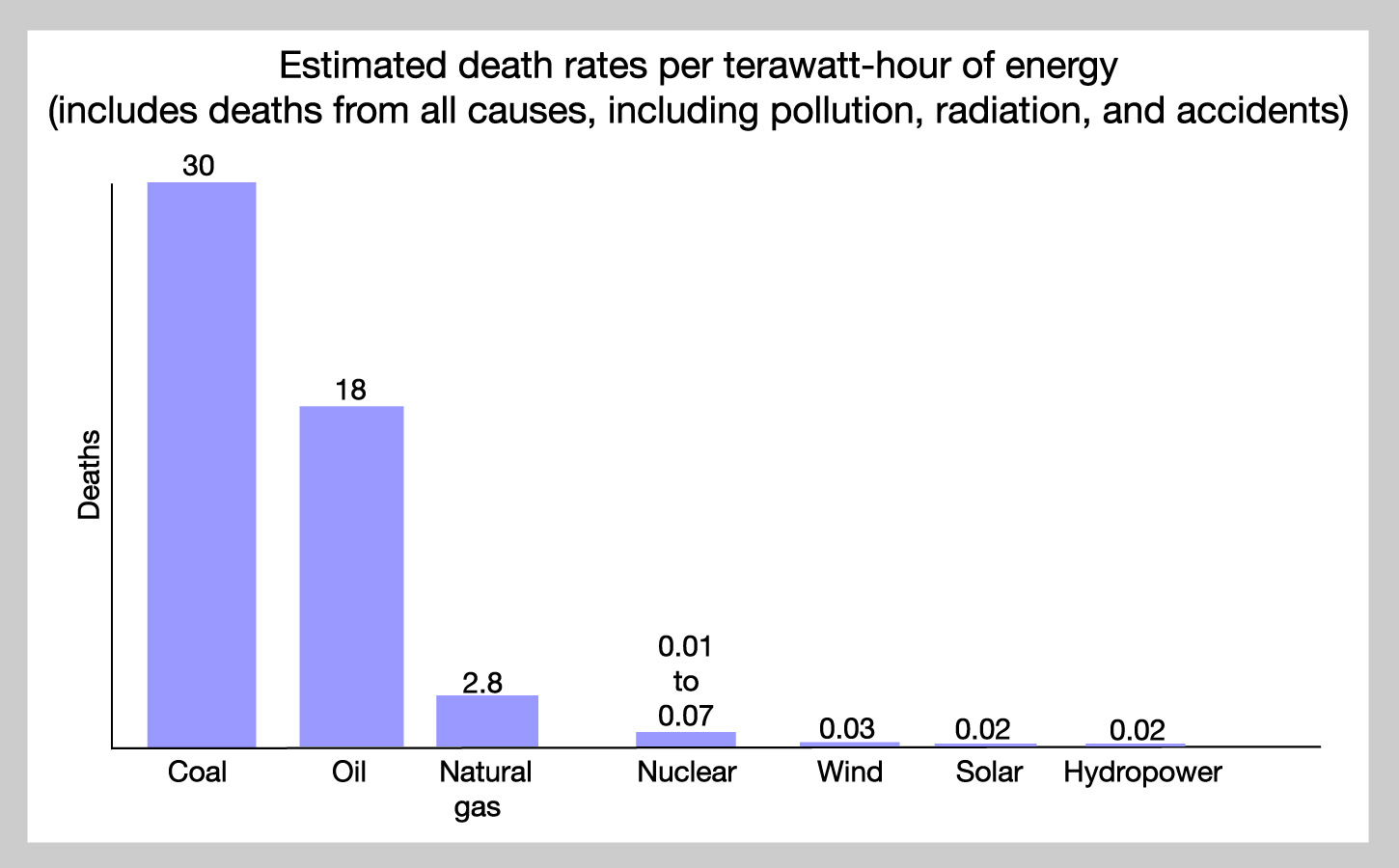
Concern — Nuclear waste: Just as you have to refill a car’s fuel tank (or recharge its batteries), nuclear power plants need fuel “refills” as well, and that means the “used up” fuel must be discarded. This discarded fuel is usually called nuclear waste , and this waste will remain dangerously radioactive for tens of thousands of years. It will therefore pose a danger to future generations unless we find a way to keep it isolated enough that no one will ever come across it by accident. So far, no one has come up with a way to permanently and safely deal with this nuclear waste.
Counterpoint: There’s no doubt that safe and permanent disposal of nuclear waste will be a major challenge. But there are two main counterpoints. First, as with accidents, there’s the comparative waste issue, and again, nuclear power comes out far ahead of fossil fuels in this comparison. For example, the total amount of waste produced by nuclear power plant in a year is what a typical coal-fired power plant creates in a single hour — and while the coal waste is much less radioactive, it is also very toxic. Plus, of course, nuclear is not putting out any of the greenhouse gases that cause global warming.
Second, it turns out that because nuclear “waste” is still radioactive, it can in principle be used to generate further energy until the remaining radioactivity is extremely low. While existing nuclear power plants can’t do this, it is possible that future nuclear power plants will be able to. In other words, instead of having to dispose of nuclear waste, we may be able to keep using it until no longer poses much danger. An added advantage of this approach is that it means we wouldn’t have to mine as much new uranium, because we would instead use existing waste as nuclear fuel. Video 7.3.1–17 summarizes the main counterpoints regrading nuclear waste.
Video 7.3.1–17 - This short video discusses the main counterpoints to concerns about nuclear waste. Note: you may also wish to read this scientifically accurate cartoon discussion of radioactive waste danger. Credit: Energy Northwest.
Concern — Nuclear terrorism or sabotage: The radioactive fuel used in nuclear power plants could be used to cause great damage if terrorists were to sabotage a nuclear power plant or to steal the fuel either from a plant or while it is being transported to a plant.
Counterpoint: This threat is a major concern, especially if we expand the use of nuclear power, since that would mean more radioactive material being transported around the world. The main counterpoint is that, in general, we successfully protect many other critical supplies and sites (such as airports and government buildings). Therefore, if we are diligent, it should be possible to protect nuclear power as well.
Concern — Spread of nuclear weapons: The fuel used in nuclear power plants cannot be used to make nuclear bombs, because it doesn’t contain enough of the bomb-making material (uranium-235). However, as discussed in the Take it to the Next Level box above, making the fuel for nuclear power plants requires a process called “enrichment,” and this same process could in principle be continued to the point where the uranium could be used for a bomb. This fact creates concern about the spread of nuclear weapons to nations or groups that don’t currently have them (which is called “nuclear proliferation”), because it makes it difficult to distinguish whether nuclear power capabilities are being built solely to generate energy or also to build nuclear weapons.
Counterpoint: Again, this is a real concern. However, there are two main counterpoints. The first is based on international agreements designed to prevent the spread of nuclear weapons. Enrichment is a complex process that requires large machines, which means these machines are not easy to hide. Therefore, as long as any nation doing enrichment for nuclear power agrees to international inspections (which are currently conducted by the International Atomic Energy Agency), it should be possible to verify that enrichment is being done only to the point of making fuel for power plants, not for making bombs. Alternatively, enrichment might be allowed in only a few places where it could be carefully controlled, with the fuel distributed for nuclear reactors around the world.
The second counterpoint is that nuclear power plants could actually help the world reduce or eliminate nuclear weapons, because existing nuclear weapons can be dismantled and have their material “de-enriched” to be used as nuclear fuel. In fact, this has already been done: From about 1991 to 2013, about 10% of the electricity used in the USA was generated by nuclear power with fuel recovered from dismantled nuclear bombs . Estimates indicate that dismantling the world’s remaining nuclear weapons could provide enough nuclear fuel to power the entire world for many years.
Concern — Nuclear power costs too much: Building nuclear power plants is very expensive (Figure 7.3.1–18), and money must also be set aside for dealing with their waste and for their eventual decommissioning, when they must be safely shut down and dismantled. As a result, nuclear power has historically proven to be much more expensive than most other energy sources, including both fossil fuels and renewables like wind and solar.

Counterpoint: This has indeed been true, but it is not inevitable that nuclear power should remain so expensive. At least part of the reason for nuclear power’s high cost can be traced to public fears (that is, all the other concerns above). These fears mean that anyone trying to build a nuclear power plant is taking a risk that the plant will be delayed or stopped by public opposition, and this type of delay ends up costing a lot of money. If public fears can be overcome (that is, if people accept the counterpoints above), the cost of nuclear power might drop dramatically, especially if accompanied by a concerted effort to standardize and improve nuclear construction.
Moreover, even if wind and solar remain cheaper, they still have the problems of being intermittent, which means they generally need “backup” from another power source. Today, that backup source is almost always fossil fuels, which are the main cause of global warming. Therefore, even if nuclear is more expensive than wind and solar, it may be necessary as a backup to those energy sources. After all, whatever the cost of nuclear power, it is almost certain to be less than the human and economic costs of global warming.
To summarize, there are several real and legitimate concerns about nuclear power, but each of them has counterpoints that might alleviate the concern.
Activity
Research a Nuclear Accident
Choose one of the three major nuclear accidents — Three Mile Island, Chernobyl, or Fukushima — to research in some depth. Prepare a 10-minute presentation in which you briefly explain what happened, what the consequences were, and whether a similar accident is likely in the future. Include a brief discussion of how you think the consequences of the accident should affect public views of nuclear power.
This is a research activity to help students learn about the famous nuclear accidents. It can be done either individually or in small groups. By having at least one student or group report on each of the accidents, the class can learn about all of them.
Claim-Evidence-Reasoning Activity
The Nuclear Option
Use this activity to help ensure you understand the issues that surround nuclear power as an option for helping to solve the problems of global warming.
- Based on what you have learned in this section, make brief lists of the benefits and the challenges of nuclear power.
- Now use evidence and reasoning to support or refute the following claim that is commonly made by opponents of nuclear power.
Claim: Nuclear energy is simply too dangerous to consider as a source of energy for humanity.
- Use evidence and reasoning to support or refute the following claim that is commonly made by supporters of nuclear power.
Claim: Stopping the emissions that cause global warming will be far more difficult if we don’t continue to use existing nuclear power plants and expand the use of nuclear power in the future.
- After completing the other parts of this activity, hold a class discussion to see if you can find a consensus about the future of nuclear power. For example, should existing nuclear power plants be turned off, should we greatly expand use of nuclear power, or something in between?
- (1) Lists will vary, but at minimum, the benefits list should include the 4 major facts listed at the very beginning of the subsection on nuclear energy, and the challenges should include dealing with the major concerns.
- (2) This may be a challenging claim, since a lot of students are likely to have come into this section believing it to be true. Moreover, we have worded it in a way that makes it subjective, since it depends on how you define “too dangerous.” Therefore, the key is to make sure that students cite their evidence and reasoning in a way that supports the position they take. Clearly, however, it will be easier to refute the claim, in particular by citing the data discussed in this section about how safe nuclear power has proven compared to other energy sources, including the data in Figure 7.3.1–16 .
- (3) This claim is also worded so that it can be argued both ways, depending on how students interpret “far more difficult.” Again, the key is making sure students are clear in the way they cite their evidence and reasoning. Note that the IPCC and most climate scientists would support this claim, citing the difficulties of trying to eliminate greenhouse emissions with renewables alone.
- (4) It may be difficult to reach a class consensus, but the discussion should be interesting.
- Note: If you have time, we recommend showing and discussing the documentary Pandora’s Promise, which makes a pro-nuclear case. It can also be assigned for home viewing.
Journal Entry
Thoughts about Nuclear Power
Write a paragraph or two in your journal about how your thoughts and understanding of nuclear power have changed after studying it in this section. For example, if you considered nuclear power to be “scary” before reading this section, has your view changed? If so, why, and if not, why not? Has your view of the tradeoffs between nuclear and fossil fuels changed? What about the tradeoffs between nuclear and renewables? Conclude by stating whether you now think nuclear should be considered as a solution for global warming, clearly explaining why or why not.
You can assign this journal entry either instead of or in addition to the above activity. As with some other journal entries, this should give students an opportunity to voice opinions and/or fears that they may not feel comfortable sharing with the entire class.
Summary — Existing Solutions to Global Warming
We’ve covered a lot of ground in here in Section 7.3.1, so it’s worth looking back to summarize what you’ve hopefully learned.
The first and most important lesson is this:
We already have technology that, at least in principle, could allow us to almost completely eliminate the emissions of greenhouse gases that cause global warming while still having plenty of energy to maintain and improve living standards around the world.
These technologies fall into three basic categories: energy efficiency, renewable energy, and nuclear energy. The first category (energy efficiency) can in principle greatly reduce our energy needs without any downsides, but efficiency alone cannot eliminate greenhouse emissions, since we will still need a lot of energy.
Therefore, in terms of replacing the fossil fuels that are causing global warming, our two basic options are renewables, especially wind and solar, and nuclear. We’ve discussed the pros and cons of these options in some detail, but at the risk of oversimplifying, the debate comes down mainly to the following:
- Wind and solar:
Pro: There is in principle plenty of energy available to meet all our energy needs through these clean, renewable sources.
Con: Scaling up use of these sources to replace fossil fuels is an enormous challenge, and one that might not be possible to meet without new technological developments for battery or other storage. - Nuclear:
Pro: It should be much easier to scale up to replace fossil fuel power, mainly because it provides the same type of steady (not intermittent) energy and doesn’t require any more land or material than fossil fuel power plants.
Con: The public has many fears about nuclear power, some of them very legitimate, and unless we can overcome these fears, it will be difficult to build new nuclear power plants.
So we’ll leave this section with the most important question of all: What technologies do you think we should use to solve the problem of global warming?
Discussion
Solving Global Warming
In small groups or as a class, discuss each of the following questions:
- How important is it that we “solve” global warming? In particular, how high of a priority should be given to implementing solutions to global warming versus other problems in the world, and how important is it that we address global warming sooner rather than later?
- Energy efficiency may be a “no brainer” in terms of making sense, but we still use many inefficient technologies, such as inefficient light bulbs and appliances, and cars that have poor fuel economy (sometimes called “gas guzzlers”). How would you encourage greater energy efficiency?
- Do you think it would be possible to replace all use of fossil fuels with renewable energy by the year 2050? Why or why not?
- Do you think it would be possible to replace all use of fossil fuels with nuclear energy by the year 2050? Why or why not?
- In terms of replacing fossil fuels, policy makers generally advocate one of two general solutions: (1) aiming for 100% renewable energy; (2) making use of both renewables and nuclear (what is sometimes called an “all of the above” strategy). If you were a government representative, which of these solutions would you advocate, and why?
This discussion is designed to help students review the major ideas covered in this section, and to form opinions about how we should implement solutions. Specific notes:
- (1) This first question should encourage students to review what they’ve learned about the consequences of global warming, so that they can intelligently discuss the level of priority it should be given.
- (2) This question should get students thinking both about individual decision making and policy choices (such as requirements that limit sales of inefficient appliances or cars) that could lead to greater efficiency.
- (3) This is an opinion-based question for which there is no clear answer. As we’ve discussed, it should be possible in principle, but only if we develop new battery or storage technologies.
- (4) This is also an opinion- based question with no clear answer, though in this case it is certainly possible based on technology alone, with the issue being whether public fears would prevent the full use of the technology.
- (5) This question should generate interesting discussion, as opinions among environmentalists and environmental organizations are quite split. There are many that favor 100% renewable, and many others that favor the “all of the above” strategy. It is worth noting, however, that the IPCC has endorsed nuclear power as a solution, and it also has strong support from the scientific community.
